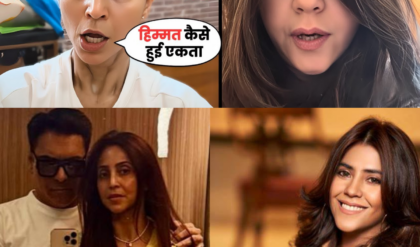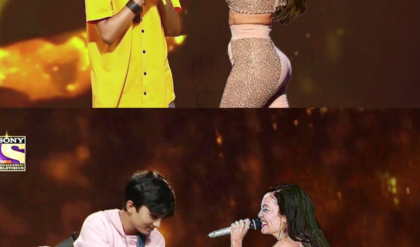Bollywood is in a big crisis! , Downfall of Bollywood | Dhruv Rathee
.
.
Bollywood is in a BIG CRISIS! | Downfall of Bollywood | Dhruv Rathee
Bollywood, India’s once-glorious film industry, has been facing a series of challenges in recent years that have led many to question its current trajectory. The industry, which has long been the source of national pride, cultural expression, and mass entertainment, seems to be undergoing a period of crisis.
From financial losses to creative stagnation, the signs of this “downfall” are evident. The growing discontent among audiences, combined with the internal challenges of Bollywood, has raised concerns about the future of Indian cinema in the global entertainment landscape.
This crisis has been particularly underscored by popular YouTuber and social commentator Dhruv Rathee, who has been vocal about the ongoing issues plaguing the film industry. With his incisive commentary on social, political, and cultural issues, Rathee has captured the attention of millions, and his take on Bollywood’s struggles has sparked important debates about the direction of Indian cinema. In his videos, Rathee highlights the creative, financial, and systemic issues that have contributed to the industry’s decline.
In this article, we explore the factors behind the current crisis in Bollywood, drawing from Rathee’s commentary and other critical perspectives. From box-office failures to a lack of original storytelling, Bollywood’s struggle to reinvent itself is more apparent than ever. But more importantly, this crisis might be a wake-up call for the industry to rethink its approach to filmmaking, audience engagement, and its role in global cinema.
The Changing Face of Bollywood: A Historical Context
To understand the current crisis in Bollywood, it’s crucial to look at its historical evolution. Bollywood, which refers to the Hindi-language film industry based in Mumbai (formerly Bombay), has had an illustrious history spanning over a century. From the black-and-white era of Mother India (1957) to the glitzy 90s with superstars like Shah Rukh Khan and Amitabh Bachchan, Bollywood has produced films that resonated not only with Indian audiences but also with people across the world.
In the late 20th and early 21st centuries, Bollywood witnessed a phase of unprecedented global recognition. Films like Lagaan (2001), Dilwale Dulhania Le Jayenge (1995), Kabhi Khushi Kabhie Gham (2001), and 3 Idiots (2009) were not just successful in India but also found success in international markets, cementing Bollywood’s place on the global map. The industry’s stars became household names worldwide, and the Hindi film industry was often viewed as a beacon of creative innovation.
However, over the last decade, Bollywood has faced a string of challenges, which have increasingly led to a perception of a “downfall” in the industry. Rathee and other commentators have observed that the charm of Bollywood has dimmed, and the reasons for this are multifaceted.
The Crisis in Bollywood: Dhruv Rathee’s Viewpoint
Dhruv Rathee, known for his analytical and fact-driven content, has been one of the more prominent voices to point out the multiple problems plaguing Bollywood. According to Rathee, the core of Bollywood’s crisis lies in its inability to adapt to the changing tastes of modern audiences. While Bollywood once dominated the cinematic landscape, the rise of regional cinema, digital platforms, and changing audience preferences have left Bollywood in a state of uncertainty.
-
Box Office Failures: The Fall of Big-Budget Films
One of the most glaring signs of the crisis in Bollywood is the repeated failure of big-budget films at the box office. Films that are marketed as blockbusters with massive star power and high production values have been struggling to recover their costs in recent years. This is in stark contrast to the earlier part of the 2000s when Bollywood films, especially those starring A-list actors, were almost guaranteed to make significant profits.
In 2022 and 2023, several highly anticipated films, including Samrat Prithviraj, Laal Singh Chaddha, Brahmastra, and Shamshera, failed to live up to expectations, despite extensive marketing campaigns and high production values. These films suffered from poor reviews, lackluster performances, and an inability to connect with audiences, leading to a significant loss in revenue. According to Rathee, the failure of such films indicates a larger systemic issue within the industry: the over-reliance on star power, formulaic scripts, and a disconnect from what the modern Indian audience truly craves.
Rathee argues that Bollywood’s focus on big stars rather than storytelling and quality filmmaking has contributed to its downfall. For years, Bollywood relied on the same formulaic genres—romantic dramas, masala entertainers, and action flicks—while neglecting the changing tastes of its audience. With the rise of more diverse and experimental films in regional cinema and on streaming platforms like Netflix, Bollywood’s refusal to adapt to these changes has hurt its relevance.
-
The Rise of Regional Cinema
Bollywood’s struggles have been exacerbated by the rise of regional cinema. While Hindi cinema has been the dominant force in Indian films, the last decade has seen a resurgence in the popularity of regional films, particularly from the South. Movies like Kantara (2022), KGF (2018), RRR (2022), and Baahubali (2015) have not only been commercial successes but also garnered critical acclaim, leading to a growing fanbase both within India and internationally.
Rathee points out that regional films have been able to tap into local cultures, narratives, and authentic storytelling, something that Bollywood has been increasingly criticized for lacking. While Bollywood has been preoccupied with remakes of South Indian films and international collaborations, regional cinema has flourished by telling original and culturally relevant stories.
Films like Vikram (2022) and Master (2021) have done exceptionally well not only in their home states but also across the country, breaking barriers of language and regionality. These films have connected with audiences on a deeper level, addressing themes and emotions that resonate with the everyday lives of people in different regions. This has created a shift in audience preferences, with many viewers now choosing regional films over mainstream Bollywood offerings.
-
Streaming Platforms and Changing Consumption Patterns
The rise of streaming platforms like Netflix, Amazon Prime, and Disney+ Hotstar has revolutionized how people consume entertainment. No longer are audiences reliant solely on theaters for their film experiences. With the convenience of watching films and shows at home, streaming services have provided a platform for a wide variety of content that Bollywood has often failed to deliver.
Films and web series that were once considered niche, such as Sacred Games (2018), Delhi Crime (2019), and Mirzapur (2018), have received global recognition, demonstrating that there is a growing appetite for diverse and authentic content. The growing popularity of content from OTT platforms has highlighted Bollywood’s failure to innovate and keep pace with changing viewer habits.
Rathee has highlighted how the increasing preference for digital content, especially among younger audiences, has led to Bollywood’s declining dominance. Younger generations are more inclined to watch content that is raw, original, and tells stories that they can relate to. Bollywood’s focus on mass appeal, melodrama, and escapist fantasy has, in many ways, alienated this key demographic.
Creative Stagnation and the Formulaic Approach
One of the key reasons for Bollywood’s decline, as discussed by Rathee, is the industry’s creative stagnation. Bollywood has long relied on a repetitive formula for success: a big star, a catchy soundtrack, an emotionally charged narrative, and a story that appeals to a broad demographic. However, this formula has been overused and is no longer yielding the same results.
The lack of innovation and risk-taking has been one of the major drawbacks of Bollywood. While films like Andhadhun (2018) and Gully Boy (2019) have managed to break the mold and win critical acclaim, they are few and far between. The industry continues to churn out remakes, sequels, and formulaic scripts, often at the cost of fresh ideas and original content. Rathee points out that Bollywood’s failure to embrace new narratives and diverse genres has made the industry predictable and stale.
In contrast, regional industries like Tamil and Telugu cinema have embraced bold storytelling, experimented with different genres, and have been more willing to take risks with content. This has allowed them to carve out a unique identity and grow their fanbase both in India and internationally.
Bollywood’s Star Culture and Its Impact
Another significant issue that Rathee highlights is Bollywood’s obsession with star power. While stars like Shah Rukh Khan, Salman Khan, and Aamir Khan were once the lifeblood of Bollywood, there has been an increasing realization that the “star culture” is not enough to carry a film anymore. The audience is no longer willing to accept mediocrity simply because a big-name actor is attached to the project.
This over-reliance on star power, Rathee argues, has led to inflated budgets and unsustainable production costs, which, in turn, contribute to the box-office failures of many films. The focus has shifted from making films that resonate with audiences to making films that please big stars and their fanbases, which often results in disappointing outcomes.
The Way Forward: A Need for Reinvention
Despite the current crisis, there is still hope for Bollywood’s future. The industry has the potential to reinvent itself, but it needs to adapt to the changing landscape of cinema. The key lies in embracing original storytelling, exploring new genres, and focusing on quality rather than quantity. Bollywood needs to move away from the reliance on big stars and formulaic scripts and focus on making films that are authentic, relatable, and experimental.
The industry also needs to work on better integration with global platforms, reaching wider audiences while staying true to its roots. Bollywood can take inspiration from regional cinema and OTT platforms, where there is a greater willingness to explore bold, unconventional themes.
Ultimately, Bollywood’s crisis is not the end, but rather an opportunity for reinvention. The path to redemption lies in creativity, diversity, and a willingness to take risks. If Bollywood can embrace these changes, it might yet have a bright future ahead in the global cinematic landscape.
Conclusion
Bollywood’s downfall, as analyzed by Dhruv Rathee and others, is a complex issue that stems from a combination of factors, including box-office failures, creative stagnation, a heavy reliance on star power, and the growing dominance of regional cinema and streaming platforms. However, this crisis also presents an opportunity for Bollywood to recalibrate and reinvent itself.
To survive and thrive in this changing era, Bollywood needs to embrace a fresh approach to filmmaking—one that prioritizes quality storytelling, originality, and diversity. As the global entertainment industry evolves, Bollywood must adapt or risk losing its once-prestigious place in the hearts of audiences worldwide. The future of Bollywood is in its own hands; it’s time for the industry to evolve beyond its old formulas and move forward with new, bold, and creative ideas.
News
Scandalous! Celebrity Caught in a Shocking Incident with a Fan in Public!”
Shocking Incident Involving Kareena Kapoor: A Fan Misbehaves in Front of the Media In a deeply unsettling incident, Bollywood actress Kareena Kapoor Khan found herself at the center of an unexpected and distressing situation when a fan reportedly touched her…
End of content
No more pages to load






